The History Of Hyundai Tiburon

The Hyundai Tiburon (also known as Hyundai Coupe) is a compact coupe produced by Hyundai since 1996. The name itself means "Shark" in Spanish. Tiburon is the name given to the current North American, Australian, New Zealand, South African, and Austrian production of the vehicle, though it is called the Hyundai Coupe in other world markets. It has also been known by the moniker Turbulence and Tuscani in the South Korean market.
The model has been released in two generations (RD and GK) over its lifespan and in that time these generations have been subject to periodic facelifts. These facelifts have attempted to keep the car up to date with various safety improvements and a mixture of changes to exterior and interior styling. The RD Tiburon was in production for 5years from 1996 to 2001. The GK Tiburon has been produced since 2002 and is still in production in its latest guise.
Hyundai officially announced that the 2008 model year will be the last for the Tiburon. While no replacement has been announced, Hyundai has officially stated that the 2010 Genesis Coupe is not a Tiburon replacement.
RD (1996-2001)
Tiburon first began production in late 1996. It was available in a few foreign markets with engine choices of either 1.6L or 1.8L. In the United States, the Tiburon was first offered in 1997 with base models using the Elantra's 1.8L 130hp (97kW) engine while the upscale FX received a 2.0L four-cylinder engine. The 2.0L was rated at 140hp (104kW) at the crankshaft (the car's manual specifies 102kW (137hp) at the flywheel). Base weight was around 2,550lb (1,150kg), giving the RD Tiburon a higher power to weight ratio than the newer GK 2.0L. The 2.0L produces a 0-60mph time of ~7.9seconds, with a 1/ 4mile time of ~16seconds. In 1998 the Tiburon lost its weaker 1.8L engine, giving both models the 2.0L. All versions of the Tiburon manufactured from 1996-2001 are known as "RD" Tiburons. There were various options, with or without ABS, 2 airbags, leather, and sunroof.
RD2 (2000-2001)
The RD2 Tiburon is an update on the original RD platform and was released for sale in 2000. The RD2 received a facelift that altered the front and rear bumpers and also provided a refreshed interior dash. In South Korea, the RD2 Tiburon was marketed as the "Tiburon Turbulence".
The RD2 headlights have separate enclosures for the high and low beams giving the four headlight look, similar to the third generation Acura Integra and the sixth generation Toyota Celica. The rear bumper is also reformed receiving larger tailights. The same 140hp (104kW) 2.0L engine was carried over producing identical performance. ABS and sunroof were available in a package.
Engineering
- 1.6L inline-4 cylinder Alpha
115hp (86kW) @ 5800rpm and 143N•m (106ft•lbf) torque @ 4,500rpm.
- 1.8L inline 4 cylinder Beta (1997 Base)
130hp (97kW) @ 6000rpm and 171N•m (126ft•lbf) torque @ 4200rpm.
- 2.0L inline 4 cylinder Beta (1997 FX, 1998-2002)
140hp (104kW) @ 6000rpm and 180N•m (133ft•lbf) torque @ 4800rpm.
From 1997 to 1999 The Tiburon was offered with a 5-speed manual transmission standard while a 4 speed automatic w/ overdrive was optional.
Performance
- 1.6litre:
Acceleration 0-60mph: 11.6seconds Top speed: 120mph (193km/ h)
- 1.8litre:
Acceleration 0-60mph: 9.0seconds Top speed: 125mph (201km/ h)
- 2.0litre:
Acceleration 0-60mph: 7.9seconds Top Speed: 140mph (225km/ h)
The previous-generation Tiburon expired after 2001. Hyundai launched a revised Tiburon in 2002 for the 2003 model year, giving it new styling, larger dimensions, and an optional V6 engine. Tiburon's wheelbase and overall length grew slightly compared to the previous version, increasing curb weight by about 200 pounds. Base and GT V6 models were offered, both with standard front side airbags and optional anti-lock brakes. Base Tiburons retained a new 138hp (103kW) 2.0-liter four-cylinder engine, while GT V6 coupes got the new 2.7-liter 172hp (128kW) V6 from Hyundai's Sonata and Santa Fe. A five-speed manual transmission was standard, and a four-speed automatic was optional. The automatic unit had a manual shift gate. Also optional on the GT V6 was a six-speed manual gearbox. Base models and GT V6 automatics rode on 16-inch tires, versus 17-inch for the GT V6 manual models. Both had standard four-wheel disc brakes. Leather upholstery was standard in the GT V6, as well as a rear spoiler (high spoiler std. on 6-speed only). Aluminum pedals and a sunroof were optional.
In 2004, all GT V6's received the high spoiler, 17" wheels, and ABS as standard equipment. A "special edition" of the GT V6 was also released. It featured a "Special Edition" decal-style badge underneath "Tiburon", sport cloth upholstery, a Kenwood stereo, red painted front brake calipers, and multigauges above the radio. Only the 6-speed and automatic transmissions were available. The special edition was available in Jet Black, Rally Red, and Sunburst Yellow only. The new design received praise from many automotive journalists, most of which compared it to the Ferrari 456.
In 2005 Hyundai facelifted the Tiburon and reshuffled the model lineup; offering GS, GT, and SE models. The SE was now a separate trim from the GT models. Hyundai's four-cylinder engine went into the GS, while the other two held the 2.7-liter V6. A five-speed manual transmission was standard. A four-speed automatic with a manual shift was optional for GS and GT models, but the SE had exclusive use of a six-speed manual gearbox. Anti-lock brakes was standard on the SE and optional for the GT coupe, which could be equipped with leather upholstery. GS coupes rode on 16-inch wheels, versus 17-inch for other models. All-disc brakes and front side airbags were standard. Anti-lock brakes were made standard on all 2006 model Tiburons.
In the UK, three models were available before and after the 2005 facelift: the 1.6S, 2.0SE and V6. The 1.6S had a single exhaust and leather seats were optional, although following the 2005 facelift half-leather seats were standard. Both other models have twin exhausts and leather seats as standard. The six-speed gearbox was also standard on the V6 model.
A popular modification saw owners of the first GK model removing the air-filter resonator box. The resonator box was located directly in front of the front left hand side wheel, behind the fender. This allowed for a greater airflow to the air filter, gaining a minimal increase of brake horse power (bhp). Hyundai, seeking cost cuts, adopted this modification for 2004+ models. Hyundai also released a new color for their 2006 Tiburon called Regatta blue, between Tidal Wave blue and Midnight blue, which is Metallic. This color is also available for the 2007 Elantra and Tiburon.
Hyundai recently announced that following the 2008 model year, the Tiburon will end production. Since Hyundai has on more than one occasion said that the Genesis coupe is not a replacement for the Tiburon, this leaves the possibility open of a future front-wheel drive sports coupe.
GK F/ L (2005 - 2006)
Hyundai conducted minor tweaks to the 'GK' model in 2005, for the outgoing named 2006. The vehicle incorporated reworked sleeker blackened "smoked" headlights, redesigned rear tail lights, more aggressive front air dam, a different range of alloy wheel designs, colored stitching on leather seats (half leather seats available for the 1.6 range).
GK F/ L2 (2007 - 2008)
A more comprehensive facelift was launched in 2007, named the Coupe SIII in markets such as the UK, this time altering the appearance of the car enough to designate it the fourth generation or GK F/ L reminiscent of the RD1 and RD2 denotations.
The headlights are thinner and angled more aggressively; somewhat similar to the original Tiburon headlights with more straight/ sharp lines. The tail lights are similar to the RD2 and GK1 but are somewhat smaller and reflect an aftermarket styling. The fenders lose the "gill fins" and other small changes are seen.
The interior is updated with brushed aluminum accents, new blue backlight scheme for gauges and instrumentation and new seats.
Equipment and safety
The exact specification depends on model and the market where it is sold but these are some of the features available:
- Anti-lock brakes, Dual Circuit with brake force distribution
- Front (variable rate) airbags and side airbags
- Side impact protection bars
- ESP Stability Control (2007)
- Traction Control (2007)
- Electric windows, sunroof
- Heated front seats
- Trip Computer
- Air Conditioning / Climate Control
- Leather / Half-leather / Cloth interior
- Sports seats
- Alloy wheels (normally 16" or 17")
- Infinity Sound system
- Additional gauges featuring torque, fuel burn rate and voltage
The 2004–2007 models received a 4/ 5 star rating from the National Highway Traffic Safety Administration in the USA.
Engineering
- 2.0L inline 4 cylinder Beta II CVVT (2004+) on the inlet valves (GK, GS)
132hp (98kW) @ 6000rpm and 184N·m (136ft·lbf) torque @ 4500rpm.
- 2.7L V6 Delta (GT, SE)
172hp (128kW) @ 6000rpm and 245N·m (181ft·lbf) torque @ 3800rpm.
In 2002 the 5-speed retained standard on the GS, GT, and GT Limited, while the upscale SE model came only with a six-speed manual. A four-speed automatic transmission with Shiftronic was available for all models.
Performance
- 2.0litre:
Acceleration 0-60mph: 9.2seconds Top speed: 130mph (209km/ h)
- 2.7litre: (Automatic)
Acceleration 0-60mph: 8.2seconds Top speed: 132mph (212km/ h)
- 2.7litre: (GT 5-speed)
Acceleration 0-60mph: 7.7seconds Top speed: 137mph (220km/ h)
- 2.7litre: (SE 6-speed)
Acceleration 0-60mph: 7.2seconds Top speed: 145mph (233km/ h)
In several markets the model is sold and branded as a Tuscani. The Tuscani wears a circular badge containing a smaller circle of black and grey horizontal bars which is overlaid with a letter 'T' painted gold on the left and silver on the right. Even in markets where the car is sold as a Hyundai Tiburon or Hyundai Coupe, the name Tuscani has become quite popular. Many cars have been modified aftermarket to be rebadged with Tuscani emblems. In Canada, a special edition of the Tiburon is sold as a "Tuscani edition". A rumour has started to circulate that Hyundai is considering a plan to branch off the Tuscani name as a complete sub brand for more exclusive, sporty, and upmarket models. The existence of the name is most likely to achieve greater sales where the Hyundai name has cloying associations with more budget products.
In some markets secondary badging may denote engine size and variations such as trim, wheel, and other options. These badges include GS, GT, SE and FX, although some use FX across the entire range available. In certain markets, certain exterior colors are not available and identification may require noticing subtle local differences such as alloy wheels, spoilers or dealer fit options such as in car entertainment systems. These can all change from year to year and from market to market, so the variation is quite significant. One notable difference is that the 1.6 engine always has a single exhaust on the right hand side, in all markets where it is sold.
- In series 2, episode 3 of Top Gear, co-host Richard Hammond reviewed the 2002 Coupe and talked about its remarkable design, performance and reasonable price, considering it to be an overall better ride than the Lexus SC430, which cost more than twice as much. It was the only Korean car to ever be posted on the "Cool" section of the show's Cool Wall.
- The 2002 Hyundai Tiburon is a playable car in the videogames Need for Speed: Underground, Need for Speed: Underground 2, Gran Turismo 4, Forza Motorsport, Forza Motorsport 2, Juiced 2: Hot Import Nights, Drift City, and Auto Modellista.
- In the music video for the South African pop song Net die een vir my, it shows the main singer, Nicholis Louw, driving in a 1990s Hyundai Tiburon.
- In the music video for the song "All These Things I Hate" from Bullet For My Valentine the main character is driving a black RD1 Tiburon.
- in the music video for the song "Remember The Name" by Fort Minor a 2005-2006 silver tiburon can be seen for a few seconds.
From Wikipedia, the free encyclopedia
More About Hyundai Tiburon
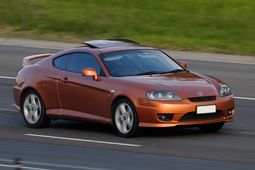
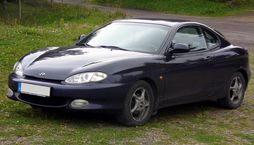
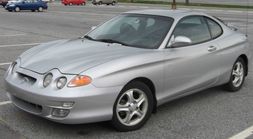
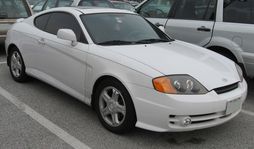
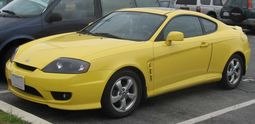
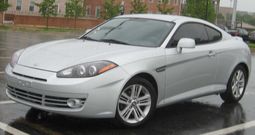
|